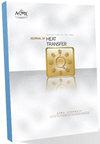Combined Effect of Bubble Size and Gas Volume Fraction On Natural Convective Heat Transfer Enhancement in Homogeneous Bubbly Flow: Eulerian-Eulerian Numerical Simulations
IF 2.8
4区 工程技术
Q2 ENGINEERING, MECHANICAL
引用次数: 0
Abstract
Natural convective heat transfer can be enhanced through either fins or riblets, wall roughness elements, or the injection of bubbles in the flow. Bubble injections in a quiescent (pseudo-turbulent) liquid phase or an already turbulent liquid phase had been shown to enhance the natural convective heat transfer from literature. However, study of the combined effect of bubble size and gas volume fraction rather than individual effect on natural convective heat transfer enhancement for homogeneous bubbly flow is lacking. The present work intends to fill in that data gap through conducting numerical simulations to study the combined effect of bubble size and gas volume fraction on natural convective heat transfer enhancement. The present numerical work employs a validated interphase force models and the Eulerian-Eulerian model. ANSYS FLUENT is used to simulate a bubbly flow in a three-dimensional rectangular channel with a natural convective heat transfer. Bubbles ranging from micro to millimeter diameter with inlet gas volume fraction varied in the range of 0.351-3.725% are injected upward to a quiescent liquid phase in a rectangular channel with a heated left wall and a cooled right wall. The flow regime is homogeneous without bubble coalescence and breakup effect. Validated computational models are employed to study the combined effect of bubble size and gas volume fraction on heat transfer enhancement. A relation between Nusselt number, bubble Reynolds number, Rayleigh number, nondimensional bubble size, and inlet gas volume fraction is constructed using the power regression method.气泡尺寸和气体体积分数对均匀气泡流动中自然对流换热增强的综合影响:欧拉-欧拉数值模拟
自然对流换热可以通过翅片或波纹、壁面粗糙度元素或在流动中注入气泡来增强。在静止的(伪湍流)液相或已经湍流的液相中注入气泡可以增强自然对流换热。然而,对于均匀气泡流动中气泡尺寸和气体体积分数对自然对流换热增强的综合影响而非单个影响的研究还很缺乏。本文拟通过数值模拟研究气泡尺寸和气体体积分数对自然对流换热强化的综合影响来填补这一数据空白。目前的数值工作采用了一个经过验证的界面力模型和欧拉-欧拉模型。利用ANSYS FLUENT模拟了具有自然对流换热的三维矩形通道中的气泡流动。在左壁加热、右壁冷却的矩形通道中,将直径从微米到毫米不等的气泡向上注入静止液相,入口气体体积分数在0.351 ~ 3.725%之间。流态均匀,无气泡聚并破碎效应。采用验证的计算模型研究了气泡尺寸和气体体积分数对强化传热的综合影响。利用幂回归方法建立了努塞尔数、气泡雷诺数、瑞利数、无量纲气泡尺寸与进口气体体积分数之间的关系。
本文章由计算机程序翻译,如有差异,请以英文原文为准。
求助全文
约1分钟内获得全文
求助全文
来源期刊
自引率
0.00%
发文量
182
审稿时长
4.7 months
期刊介绍:
Topical areas including, but not limited to: Biological heat and mass transfer; Combustion and reactive flows; Conduction; Electronic and photonic cooling; Evaporation, boiling, and condensation; Experimental techniques; Forced convection; Heat exchanger fundamentals; Heat transfer enhancement; Combined heat and mass transfer; Heat transfer in manufacturing; Jets, wakes, and impingement cooling; Melting and solidification; Microscale and nanoscale heat and mass transfer; Natural and mixed convection; Porous media; Radiative heat transfer; Thermal systems; Two-phase flow and heat transfer. Such topical areas may be seen in: Aerospace; The environment; Gas turbines; Biotechnology; Electronic and photonic processes and equipment; Energy systems, Fire and combustion, heat pipes, manufacturing and materials processing, low temperature and arctic region heat transfer; Refrigeration and air conditioning; Homeland security systems; Multi-phase processes; Microscale and nanoscale devices and processes.

 求助内容:
求助内容: 应助结果提醒方式:
应助结果提醒方式:


